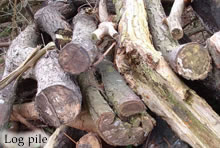Food & Shelter
Garden Wildlife food and shelter
There are numerous ways to encourage wildlife into your garden either by feeding them or providing shelters and homes.
Eating Out
Remember to feed birds regularly during the winter months. Your local visitors will get used to food stations and will rely on you at the expense of foraging elsewhere during cold spells.
Bird Tables
There are numerous types available of varying designs and suitability. Avoid those with the little thatched roofs and a small table surface. Go for a big table top with good visibility as birds like to see any danger coming. You might get a few more bullies like starlings, but that’s better than no birds at all.
Not all the food will get eaten during the winter if you put out large quantities as late as lunchtime. It might, however, be the perfect invitation to any rats in the area so try to limit the amount you put out each day.
If you want to put seed out for the birds, buy in bulk. It will save you money over the longer term. Regular seed scoops every morning will ensure that you attract a wide range of some of the smaller species and not just the larger bullies.
Feeding the birds in the summer, is not as frowned upon as it use to be. Birds will still come to the bird table to feed in the spring and summer months, but avoid putting out big lumps of bread or whole peanuts, as they can choke young birds still in the nest.
Bird Baths
Many people who feed birds often forget that water is equally important both for drinking and bathing. Either buy a bird bath or use a similar container that will hold a shallow pool. Also remember that it is particularly important to keep a bird bath free of ice in winter by using water from a kettle, as other sources of drinking water are likely to be unavailable.
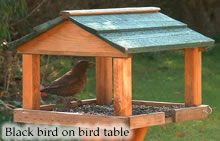
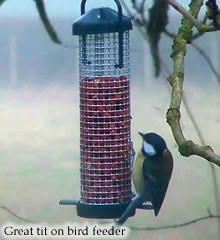
Nest Boxes
Putting up a bird nest box is a simple way to help the birds. It doesn’t matter if your garden is small, as every garden can accommodate at least one nest box to entice a Blue Tit, House Sparrow or Robin. Why not try a House Martin nest box under the eaves?
There are several different types of nest box to choose from, each designed to appeal to a different potential resident. Further details can be found below.
If you wish to clean out your nestbox, do it in the late autumn and after any late broods have left the box. Some birds like Wrens will also use a nestbox to roost in during the cold winter weather, so late October and November are ideal months for this job. Cleaning the box helps to get rid of parasites which can overwinter in old nesting material and infest adults or youngsters in the following year.
Avoid putting your box in open sites where they will be exposed to the full heat of the sun. Also make sure that the box does not face into the prevaling wind where it will be drenched with rain. Ensure that there is no easy access route for predators like crows, magpies or cats and that there is a clear flight path for the birds using the box.
What Birds Use What Box?
Blue and Great Tits
Blue and great tits require an enclosed nestbox with a hole size of about 28mm. These are often the most successful boxes in attracting nesting birds into the garden. Bird boxes are very easy to make and you don’t have to be an expert carpenter. In fact the more rustic the box the better! You can find plans for various bird box designs but the precise dimensions are not critical so use whatever wood offcuts you have to hand. Rough-cut untreated timber is best. Your aim should be to construct a box with an internal floor dimension of about 12 to 15cm square. Cut the side panels to be between 17 and 25cm long incorporating a slope so that water will run off the roof when it is attached. Make the back panel longer than the front so that you can attach the box to its support with a nail. Once you’ve cut out the panels nail them together using oval nails and secure the lid using a hinge made from a piece of roofing felt or flexible plastic so that you can get into the box to clean it out at the end of the year. Attach a small hook and eye on both ends of the nestbox lid to stop predators lifting it up. Drill the hole fairly high up on one side of the box. Fitting a metal plate around the entrance hole will give extra protection from possible predation by woodpeckers or squirrels. Place the box at least 2m above ground level.
House and Tree Sparrows
Sparrows like a similar design to the tit box but with a slighter larger diameter hole of 32mm.
Robin and Spotted Flycatchers
Robins and thrushes will use a good size open fronted nestbox. Make the box with similar dimensions to the blue tit box but instead of drilling a hole in the side of the box reduce the height of the front panel to create a fairly large rectangular opening. Locate in climbers on a wall or fence at least 1.5m above ground level where the nest will be protected from predators.
Spotted Flycatcher
A species which is declining rapidly in Britain is the spotted flycatcher. Again locate an open fronted nestbox in amongst ivy, clematis or honeysuckle on a wall or tall fence.
Owls or Jackdaws
A barrel type box with one end half cut off. Situated high in a large tree or on the side of a building which are ideal for kestrels, little owls or jackdaws. Only worth considering if you have the space in a rural setting.
House Martin
Your best option is to buy an artificial cup. Screw it to the timber beneath the eaves and it is best to place several together in a small group as house martins prefer to nest in small colonies. The mess under a nest can be prevented by putting a small wooden board underneath to catch the droppings.
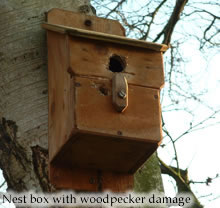
Other Boxes
Bat Boxes
Bats also need boxes as well. Just a few things to consider if you wish to put a bat box up in your garden. The design of the bat box is similar to a bird box with a small slit on the underside. The box should also have a rough grooved back on the inside made by shallow saw cuts about 10 to 15mm apart. Use rough-cut softwood for the box and do not treat the timber with any preservatives or paint. Try and get the box as high up in a tree or on the side of a building in a fairly open position to give a clear flight path to and from the box. Face the boxes south so they remain warm.
Please do not disturb any bat boxes – it is illegal to disturb bats. A licenced batworker from your local group may be able to come and inspect them. To see if your box is being used, watch the box on a warm summer evening to see the bats leave or look for signs of droppings on the ground below.
Hedgehog Box
If you construct a hedgehog box, you might have the delight of hedgehogs truffling around your garden eating slugs and snails. A hedgehog box is a small kennel like box with a ramp, stuffed with straw or newspaper to keep the hedgehogs cosy during the winter months. The home should be sheltered up against a fence under some bushes.
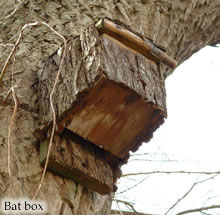
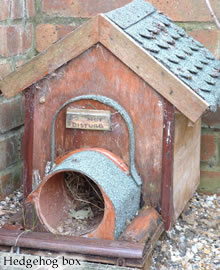
Log piles
The ever trusty log pile you see stacked in some woods or in the corner of a garden can be a haven for wildlife. Hedgehogs, beetles and amphibians all like a good log pile for sheleter and food. If you only have room for one log pile try and locate it in a damp, shady corner, perhaps under some trees. Put the largest logs flush with the ground and pile some leaves over the top. If your garden is large enough why not try building another pile in a sunnier area which will entice a different range of insects users.
